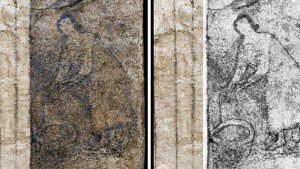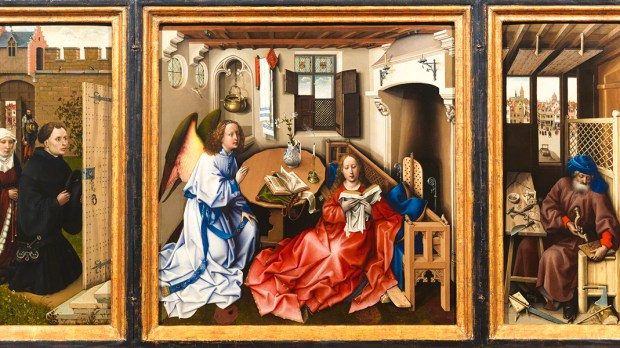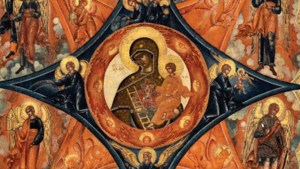Lenten Campaign 2025
This content is free of charge, as are all our articles.
Support us with a donation that is tax-deductible and enable us to continue to reach millions of readers.
Unlike some other iconographic motifs in Christian art, the Annunciation scene is narrated in detail in at least one of the Gospels –Luke’s. Although another, shorter Annunciation scene can be found in the Gospel of Matthew (chapter 1, verses 18 to 25, the Annunciation to Joseph) most artists chose to use the Gospel of Luke as the narrative source for their images. This is not only because of the wealth of detail contained in Luke’s text, but also because of the rich symbolic and theological implications (especially Mariological ones) that could be addressed in a graphic “translation” of the Gospel text.
Depictions of the Annunciation were somewhat common even in early Christianity, the earliest being found in the catacombs of Priscilla, which, according to some sources, date back to the 4th century. From these early roots, the subject became part of the graphic repertoire of almost every great artist. These artists and their audiences were often well aware of the deep, rich symbolism contained in the scene, but it’s a visual language with which we are less familiar today.
Mary’s Throne
For example, some Annunciation images, especially medieval images from the 12th and 13th centuries, include “Mary’s Throne,” an elaborate seat on which the Virgin sits to receive the angels’ announcement. With its rich upholstery and carvings (often including the lion heads that adorned King Solomon’s throne), the inclusion of this anachronistic piece of furniture was intended to emphasize Mary’s title as the Seat of Wisdom and her authority as Queen of Heaven, Regina Caeli. Although the official Catholic doctrine of the Virgin’s queenship was defined in Pius XII’s encyclical Ad Caeli Reginam in 1954, tradition has called Mary “Queen of Heaven” since the 5th century, shortly after the Council of Ephesus proclaimed Mary the Mother of God.
The Virgin’s ear
A dove, which traditionally represents the Holy Spirit in Christian art (based on the account of Jesus’ baptism by John), plays an interesting role in some medieval images of the Annunciation. While the most common depiction shows the dove hovering above Mary (“the Spirit of the Most High will overshadow you”), in some depictions the dove flies toward the Virgin’s ear. The reason for this is to be found in some early texts of the Christian tradition, which associate the virgin conception of Jesus with “listening” to the words of the angel, implying that listening to the Word of God makes the soul fruitful. In the fourth century, Ephrem the Syrian (“the greatest poet of the patristic age, the only theologian-poet to stand beside Dante,” as Robert Murray would say) wrote:
Like the burning bush on Horeb (Mount Sinai), which carried God in the heart of the flames, so Mary brought Christ into her virginity: through her ear the divine Word of the Father entered and dwelt secretly in her womb.
Mary’s book
It is not uncommon to find Mary reading a book rather than working at a spindle or undertaking some other domestic task. According to some sources, this is due to the influence of Franciscan spirituality, which emphasized Mary’s piety. The book Mary is usually holding is a Psalter, suggesting that she was praying when Gabriel delivered the message. Some artists would go further and make the book Mary is reading not a Psalter but the Book of Isaiah, which contains the prophecy of a virgin conceiving: Isaiah 7:14: “And the Lord himself will give you a sign. Behold, a virgin shall conceive and bear a son, and shall call his name Immanuel.”
Of course, books as we know them did not exist in Mary’s time; artists used the objects of their own world to convey the message.
Hortus Conclusus
Also, most of the Annunciation scenes take place in enclosed spaces. This is all the more interesting because it is a reference not only to Mary’s virginity but also to the Song of Solomon. In the Song of Songs, we read:
“Hortus conclusus soror mea, sponsa, hortus conclusus, fons signatus” (“An enclosed garden is my sister, my spouse; an enclosed garden, a sealed well”
Song of Songs, 4:12.
This enclosed garden (the famed medieval hortus conclusus) was, of course, understood as a direct reference to Mary’s perpetual virginity and her fertile yet closed womb, which was to remain untouched. To represent this, most Annunciation scenes include a walled garden as part of their staging. This is even more evident in perhaps the most famous Annunciation scene of all: Fra Angelico’s.



